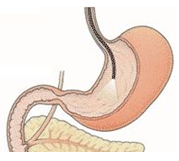Preparation
For the doctor to be able to complete the examination, you need to be fasting. This means that you can’t drink or eat at least six hours before the examination. If you only consume liquids, it is sufficient with three hours of fasting.
If you are taking any vital medications, you can take this with a small glass of water in the morning.
Tablet drugs for diabetes should not be taken until after the examination.
If you take any ulcer medications (Nexium, Omeprazol, Lanzoprazol, Pantoprazol, Esomeprazol) you should leave this out one week before the examination, as this eases the opportunity to detect ulcer bacteria. Instead OTC drugs can be used – for example Acinil, Kuracil or likewise.
If you take any blood thinning medications (Marevan), you should pause these three days before the examination.
The examination
The examination is done in left side position after a light local anesthesia in the throat. Unpleasant reflexes are hereby minimized. If estimated to be necessary, calming drugs can the administered in a blood vessel in the arm, making you relax. If you have dentures these will be removed before the examination. During the examination you wear a mouth guard.
You will be asked to swallow, and the doctor leads the gastroscope through your mouth and esophagus to the stomach and further down to your duodenum.
Small tissue samples (biopsies) for further examination can be taken without any pain during the examination.
How long does the examination take?
The gastroscopy itself takes about five minutes and you will immediately after the examination get to know the results. If any tissue samples have been collected, the results will usually be available after approximately two weeks.
Side effects
The examination usually doesn’t hurt, but when air is pumped into the stomach during the examination, it can result in a slightly squeezing sensation afterwards and an urge to belch.
Complications
The examination is considered to be safe and with a very small risk (less than 0,1%) of complications. Otherwise it is mostly seen as a light stinging in the throat or air in the bowels, which is entirely transient.
Observation after examination
If you have had any calming medications during the examination you will usually need to be observed a bit, but otherwise you can leave the clinic immediately. Because of the local anesthesia you’re not allowed to drink or eat the first hour after the examination, because of the risk of aspiration. Afterwards you can resume normal activities.
If you have received calming medications you’re not allowed to drive for the rest of the day.

